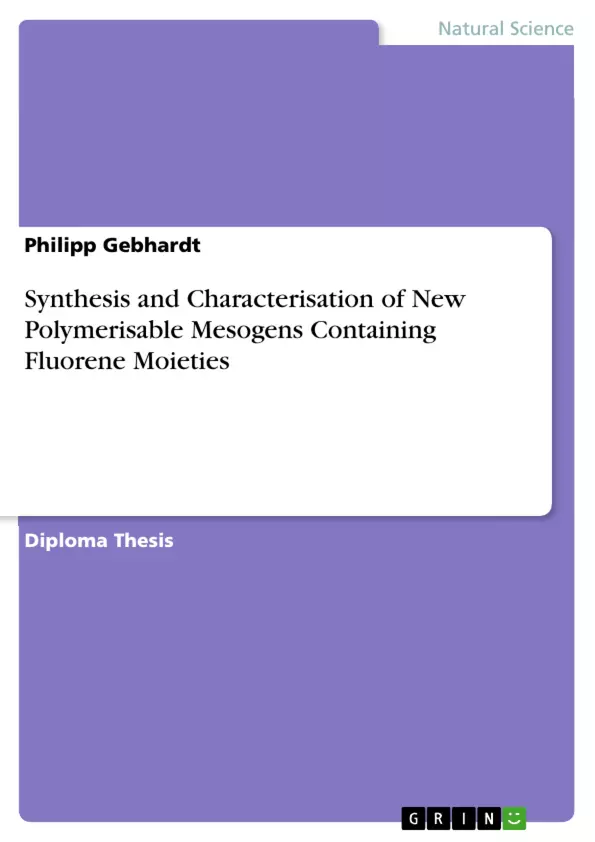In der vorliegenden Arbeit werden drei neue Mesogene hergestellt. Das sind Moleküle mit
flüssigkristallinem Verhalten in einem bestimmten Temperaturbereich. Über die Sonogashira Kreuzkupplungsreaktion wurden Dreifachbindungen eingbracht. Dies führt zu hoher Elektronendichte und guter Polarisierbarkeit. Eines der Moleküle ist ein direaktives Monomer zur Herstellung
eines dreidimensionalen Netzwerkes. Außerdem zeigen die Verbindungen Fluoreszenz
und eröffnen Möglichkeiten für die Verbesserung elektro-optischer Geräte wie z.B. LCDs.
Diese Diplomarbeit beschreibt die Synthese der neuen Mesogene und die Aufklärung
ihrer Struktur mit FT-IR, 1H und 13C NMR. Der Einfluss der Struktur auf den
flüssigkristallinen Temperaturbereich wird diskutiert, und die Flüssigkristalleigenschaften
werden polarisationsmikroskopisch und kalorimetrisch (DSC) untersucht.
Außerdem wird diskutiert, wie mit Fotopolymerisation orientierte Dünnfilme hergestellt
werden können und wie man ihre Orientierung bestimmt.
Inhaltsverzeichnis (Table of Contents)
- Summary
- Introduction
- Experimental Section
- Synthesis
- Characterization
- Results and Discussion
- Thermotropic Properties
- Liquid Crystalline Properties
- Oriented Thin Films
Zielsetzung und Themenschwerpunkte (Objectives and Key Themes)
This diploma thesis aims to synthesize and characterize three novel mesogens containing fluorene moieties. The work focuses on the synthesis, characterization of the thermotropic and liquid crystalline properties, and the preparation of oriented thin films of these new materials.
- Synthesis of new polymerisable mesogens with fluorene moieties.
- Characterization of the synthesized mesogens using various techniques (FT-IR, NMR, Polarized Microscopy, DSC).
- Investigation of the influence of molecular structure on thermotropic properties.
- Examination of liquid crystalline properties and preparation of oriented thin films.
- Exploration of potential applications in electro-optical devices.
Zusammenfassung der Kapitel (Chapter Summaries)
The Summary provides a concise overview of liquid crystals, their properties, and the potential of photopolymerizable groups for creating materials with special qualities. The Introduction section details the background of liquid crystals and the motivation for the research. The Experimental Section describes the synthesis of three novel mesogens and their subsequent characterization using techniques such as FT-IR, ¹H and ¹³C NMR spectroscopy. The Results and Discussion section presents the findings related to the thermotropic properties, liquid crystalline behavior, and the preparation and characterization of oriented thin films. Details regarding the specific results and conclusions are omitted to avoid spoilers.
Schlüsselwörter (Keywords)
Liquid crystals, mesogens, fluorene, photopolymerization, synthesis, characterization, thermotropic properties, liquid crystalline properties, oriented thin films, electro-optical devices, FT-IR, NMR, DSC, polarized microscopy.
- Quote paper
- Dipl.-Ing (FH) Philipp Gebhardt (Author), 2006, Synthesis and Characterisation of New Polymerisable Mesogens Containing Fluorene Moieties, Munich, GRIN Verlag, https://www.grin.com/document/186607



